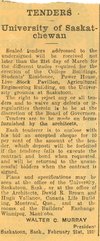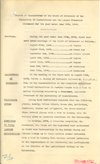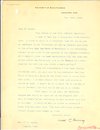“There are no buildings erected, no staff and no equipment” – Establishing a Framework
“That this impressive establishment of higher learning in a northern latitude of a prairie region has come to be, …is a miracle which, because we look at it every day, we do not see.” When Carlyle King wrote these words he was considering the University in its fiftieth year, already well established. But there was certainly something of the miraculous in how well, and how quickly, many of the foundational matters were managed within the University’s first few years. Indeed, it is remarkable to consider: everything from designing the crest to designing buildings, from selecting the University colours to selecting its faculty, had to be managed…without delay. 1
The 1909 budget [Page 1, Page 2, Page 3, Page 4, Page 5, Page 6, Page 7] is fascinating, by modern standards, for its simplicity. Then, as now, salaries accounted for the majority of expenditures: 57.47% -- and that, for only three employees: president, registrar, and caretaker. However, it is interesting to note the amount spent on travel: a further 40.84% of total expenditures. In part this included bringing Board members together, or the cost of subcommittee members to interview prospective candidates for president; but equally important were the numerous “fact-finding” missions to other universities. As had the Board earlier, in trying to establish baseline comparisons, Murray consulted widely on a variety of issues.
Not everything went entirely smoothly – Murray forgot his valise at the train station and had to return for it [Page 1, Page 2]; some payments went astray, causing a flurry of curt correspondence from suppliers. But on the whole, an astonishing amount of work was achieved relatively seamlessly, in an extraordinarily short period of time.
Importantly, a proposed amendment to the University Act, made "general provision to the effect that the Board of Governors of the University...have the same jurisdiction over the land comprised within the University site as the Council of a municipality has over the area within a municipality."
And then there were the details. A friend and colleague from Dalhousie, Archibald MacMechan, with whom Murray was in correspondence, clearly understood Murray was in his element. “University building seems a right joyous work, if I may draw inferences from your exhilarating communication,” he wrote, [Page 1, Page 2, Page 3, Page 4, Page 5, Page 6], before going on to address Murray’s ideas for a University crest and shield.
The most interesting explanation for how the University came to a decision on its official colours – green and white -- comes from a draft history written by A.S. Morton. In it, he states:
Here on a late afternoon, when the students had gone and the library had become a faculty room, the University colours were chosen. Alberta had already pre-empted the obviously right colours for a prairie university, the colours of wheat in leaf and sheaf. On Professor Grieg's design, pennants had been made in various combinations of colours, and were spread on the table. There was a moment's silence, and then Professor Bateman stepped forward and touched the green and white. 'The Irishman has spoken, so be it,' said President Murray; and so it was.





